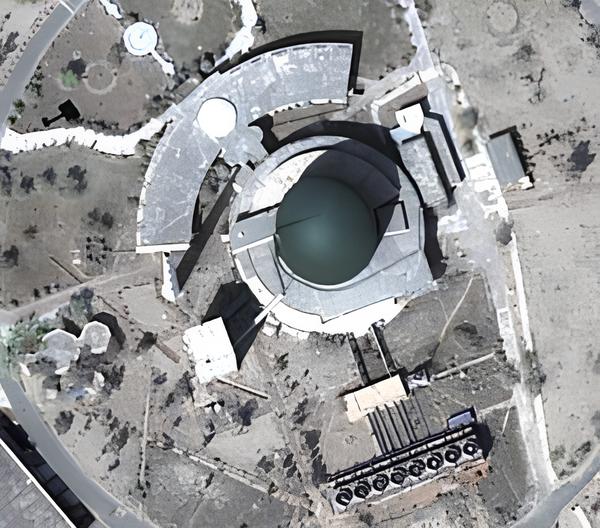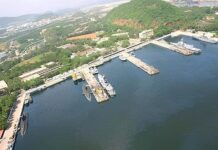Smart Nuclear Fuel Processing at Khushab Complex
Pakistan’s Khushab nuclear complex, located in Punjab province, sits at the heart of the country’s weapons-grade plutonium production effort. This facility stands apart from standard nuclear power plants, thanks to its specialized heavy-water-moderated reactors – four in total – that collectively produce significant amounts of both plutonium and tritium, two essential ingredients for modern nuclear weapon designs. Estimates suggest that Pakistan currently maintains a stockpile of around 170 nuclear devices, each requiring on the order of 10 grams of tritium to achieve boosted fission yields. By leveraging short irradiation cycles, uranium metal fuels, and potentially lithium-6 doping, these reactors can generate not only the desired high-purity 239Pu (weapons-grade plutonium) but also tritium-albeit at levels that may be constrained by operational inefficiencies.
A pivotal enabler in this setup is heavy water (D2O), produced onsite using hydrogen sulfide (H2S) exchange technology. Heavy water allows the use of natural or low-enriched uranium, making the process more flexible and cost-effective for weapons purposes. Additionally, these reactors can be tuned to shorter burnups – around 5-6 MWd/kg – to keep the plutonium at 239Pu 90 wt%. Tritium emerges from two main pathways: neutron capture in deuterium (within the D2O) and irradiation of lithium-6 (either in targets or doped into reactor elements). Because tritium decays at a rate of 5.6% per year, Pakistan must replenish its stockpile constantly to keep existing warheads operational, which, in turn, shapes how Khushab’s reactors might be run-whether in single-batch modes or partial/ continuous recycling to maximize throughput of weapons-usable materials.
This article:
1. Examines the Khushab Reactors’ Design and Operation
• Outlining the four heavy-water reactors, their typical power ranges, and why short-cycle irradiation is crucial for achieving weapons-grade plutonium.
• Highlighting the importance of uranium metal fuel and describe how its properties facilitate rapid breed-out of 239Pu .
2. Explore Heavy-Water Production and Lithium-6 Doping
• Detailing the hydrogen sulfide exchange process that supplies Khushab’s heavy water.
• Explaining the use of lithium-6 targets or doping, illustrating how tritium is generated in tandem with plutonium.
3. Analyzing Tritium Requirements for an Arsenal of 170 Devices
• Demonstrating how tritium’s half-life drives annual replenishment needs for existing warheads.
• Presenting a more realistic tritium production range (down 30-35% from theoretical maxima) and show how this impacts the number of additional weapons each year.
4. Quantify the Potential for New Warhead Production
• By comparing the available plutonium output and the leftover tritium to calculate 3-5 new boosted devices per annum.
• Discussing how short reactor cycles, frequent refueling, or partial reloads can amplify or constrain these figures.
By piecing together these reactor operations, fuel cycles, and radioactive by-products, we gain a clearer view of how Pakistan sustains and potentially expands its nuclear arsenal. The Khushab complex emerges as a technically sophisticated enterprise that, through judicious use of heavy water, uranium metal fuel, and lithium doping, can co-produce high-quality plutonium and tritium. Understanding these processes, along with the numbers that shape arsenal maintenance and growth, remains central to grasping the full scope of Pakistan’s nuclear posture.
ALSO READ: Pakistan Army rubbishes Imran Khan allegations; says nukes are safe
Operational Layout: Three Modes of Khushab Reactor Operations
One of the distinctive features of the Khushab heavy-water reactors is their flexibility in how they can be fueled and operated. Depending on Pakistan’s objectives-tritium production for boosting to maximizing weapons grade Plutonium production-each reactor can be run in a specific mode. These modes differ in terms of fuel cycle length, lithium-6 doping, and burnup levels. Below is an outline of the three principal modes:
1. Baseline “Clean Core” Mode
Objective: Higher burnup for somewhat more conventional operations, not aimed at producing weapons-grade plutonium.
A. Fuel & Burnup
• Typically uses low-enriched uranium (could be 3.5-4% 235U) or even natural uranium, depending on design.
• Operates with longer irradiation cycles (e.g.12-18 months, analogous to some commercial or research reactors) to extract more energy per kilogram of fuel.
• The resulting plutonium has a higher concentration of 240Pu and other heavier isotopes (e.g. 241Pu), making it unsuitable for weapons-grade needs.
B. Tritium Production
• Primarily from neutron capture in deuterium within the heavy-water moderator; lithium doping is minimal or absent.
• Yields moderate amounts of tritium-tied to total neutron flux and operational conditions-but significantly less than a dedicated tritium-focused cycle.
C. Fuel Recycling
• Often a once-through approach or partial reload for experimental or civilian use.
• This mode is not optimized for short discharge or high Li doping, so the impetus for reprocessing for weapons material is low.
Outcome:
• A “clean core” yields relatively higher burnup but non-weapons-grade plutonium.
• Tritium production is secondary, mostly a side effect of heavy-water usage, rather than a targeted outcome.
2. “Tritium Core” Mode
Objective: Maximize tritium output-especially if the goal is to build or maintain boosted fission devices.
A. Fuel & Li-6 Doping
• The reactor can still use standard or lightly enriched uranium.
• Lithium-6 doping (via targets) is significantly increased, so a greater fraction of neutrons produce 3H (tritium).
B. Cycle Length & Burnup
• Can vary: some operators maintain a moderate cycle to strike a balance between tritium generation and overall reactor output.
• Plutonium is still produced but has higher isotopic contamination (more 240Pu, 241Pu ) because the fuel remains in the core longer.
C. Tritium Handling
• Larger emphasis on tritium recovery and purification (through dedicated tritium extraction systems).
• If the moderator or coolant is heavily doped with Li-6, specialized facilities are needed to capture the tritium.
Outcome:
• High tritium yield due to lithium captures, but plutonium is not weapons-grade (longer irradiation times degrade the 239Pu purity).
• Useful when the operator’s main concern is sustaining or expanding tritium stockpiles.
3. “Co-Production Core” Mode
Objective: Simultaneously produce weapons-grade plutonium (90% 239Pu) and significant tritium in one cycle.
A. Short Irradiation for Pu
• The fuel (often uranium metal for efficient breeding and short residence) is discharged at low burnup (e.g., 5-6 MWd/kg).
• This ensures the plutonium remains high in 239Pu content, avoiding excessive 240Pu buildup.
B. Enhanced Li-6 Doping
• To drive up tritium production, operators may incorporate additional Li-6.
• Each short cycle yields a batch of both high-purity plutonium and a notable quantity of tritium (recovered post-irradiation).
C. Frequent Refueling / Partial Reload
• Because burnup is capped so low, the reactor must be refueled more often (possibly every few months).
• This leads to frequent shutdowns or continuous on-power refueling (if the reactor design allows).
• Spent fuel is quickly reprocessed to extract the newly bred 239Pu .
Outcome:
• Achieves both nuclear weapons materials in a single reactor cycle.
• Less efficient in terms of energy production (since the fuel is discharged prematurely).
• Typically the best approach for maximizing warhead potential: 90% 239Pu plus tens of grams to over a hundred grams of tritium per year (depending on the reactor size and doping).
ALSO READ: NUCLEAR WEAPONS: Nuclear Dynamics in South Asia
How These Modes Impact Khushab’s Output
A. Mode Selection is Driven by Objectives
• Pakistan can switch between or balance these modes across its four Khushab reactors, depending on whether it prioritizes straightforward electricity/research (clean core), high tritium (tritium core), or co-producing tritium and weapons-grade plutonium (co-production core).
• In practice, open-source assessments suggest co-production might be favored if the goal is to maintain a steady stream of both quality plutonium and sufficient tritium.
B. Material Throughput
• For co-production or tritium-focused modes, the reactors see frequent short cycles -> more fresh or recycled fuel required.
• Single-batch or partial reload patterns ensure 239Pu is extracted before significant neutron capture forms unwanted isotopes (240Pu, etc.).
C. Arsenal Growth
• Recent estimates place Pakistan’s arsenal at 170 nuclear devices.
• If co-production is pursued, each Khushab reactor can yield a certain fraction of the required plutonium plus tens of grams of tritium per year, enough to maintain existing warheads (due to tritium decay) and produce 3-5 new devices annually in aggregate-depending on operational efficiency and doping strategies.
By adjusting among these three modes, Khushab’s operators effectively control the balance of weapons-grade plutonium, tritium yield, and overall burnup. This operational flexibility is what makes the Khushab complex central to Pakistan’s nuclear weapons program-allowing shifts in strategy as material needs evolve.
Tritium Requirements and Warhead Production Potential
An integral part of Pakistan’s nuclear weapons program revolves around managing tritium 3H – a short-lived isotope essential to boost the yield of fission warheads. Because tritium decays relatively quickly, maintaining and expanding a tritium stockpile becomes a continuous operational concern. This section explores how Pakistan’s estimated arsenal of 170 devices might drive ongoing tritium needs and how Khushab’s production fits into meeting those demands while still enabling the manufacture of new warheads.
A. Existing Arsenal: Decay and Annual Replenishment
• Tritium has a half-life of 12.32 years, meaning it decays at about 5.6% per year. Consequently, each device loses a fraction of its original T load annually.
B. Annual Top-Up Needs
• Each device’s 10 g T inventory diminishes by around 0.56 g per year (5.6% of 10 g).
• Multiplied by 170 devices, the entire arsenal loses an estimated 95 grams of T annually.
• Replacing that 95 g is necessary to keep the boosted warheads at full potency.
C. Role of Purity
• It is crucial that only high-purity tritium-free of contaminants-is used in warheads.
• Because tritium often needs re-extraction and purification, Pakistan’s actual annual requirement may be somewhat higher than 95 g to account for processing losses.
Tritium Production at Khushab
A. Reduced Output Estimates
• Under ideal “co-production” mode, open-source estimates once placed the four Khushab reactors’ total tritium capacity near 200 g per year.
• However, factoring in operational inefficiencies (maintenance downtime, suboptimal lithium doping, partial cycles), a 30-35% reduction is realistic.
• This lowers the annual production to around 130-140 g across all four reactors.
B. Meeting the Arsenal’s Replenishment
• If Khushab provides 130-140 g T per year, then 95 g must go to replace decayed tritium in existing warheads.
• That leaves 35-45 g surplus T for expansion or other strategic reserves.
C. Tritium Extraction & Handling
• Whether produced via lithium-6 doping (in metallic Li targets or Li-bearing coolant) or as a by-product of heavy-water operation, tritium must be removed from reactor systems.
• Dedicated tritium recovery facilities (and possibly enrichment systems) are needed to purify T to weapons-grade quality.
• This adds complexity and expense but is essential for ensuring a reliable supply of boost-quality tritium.
Plutonium and the Production of New Warheads
A. Plutonium Availability
• Short burnups (5-6 MWd/kg) at Khushab produce weapons-grade plutonium with 90 wt% 239Pu.
• Aggregate annual output from the four reactors can reach tens of kilograms of Pu-enough for several warheads if each requires 5-8 kg.
B. Tritium-Driven Bottleneck
• Even if plutonium is plentiful, tritium often becomes the limiting factor for assembling new boosted warheads.
• With an estimated 35-45g leftover per year (after replenishing the existing stockpile), the amount of new weapons possible depends on each warhead’s T load.
C. 3-5 New Devices per Year
• A typical boosted device might again use 10 g of tritium.
• Given 35-45g of surplus, 3-4 new warheads per year are comfortably supported.
• Some slight year-to-year variance (e.g., improved Li-6 doping or improved reactor uptime) might push this figure to 5 in especially productive periods.
Through these interwoven processes, Khushab’s reactors uphold Pakistan’s capacity to maintain an existing arsenal of 170 devices, each reliant on regular tritium top-ups, while still enabling an incremental growth in warhead count of 3-5 new boosted devices per year. The precise output each year hinges on reactor uptime, doping strategies, and reprocessing throughput-but in broad terms, this arrangement presents a robust pathway to sustaining and modestly expanding a plutonium-based, boosted weapon program.
Technical Underpinnings: Uranium Metal Fuel, Heavy Water Production, and Lithium-6
The Khushab reactors derive their unique dual-production capability-of weapons-grade plutonium and tritium-from a combination of fuel choices, moderator technology, and isotopic doping. This section delves deeper into these critical elements, explaining why uranium metal is chosen over typical uranium oxide, how heavy water is produced and utilized, and the significance of lithium-6 in enhancing tritium yields.
1. Uranium Metal Fuel
a. Why Metal Fuel Instead of Oxide
• Higher Density: Uranium metal has a greater density of fissile atoms compared to uranium oxide (UO2), which can favor faster conversion of 238Pu into 239Pu.
• Rapid Neutron Economy: Short-cycle or low-burnup reactors benefit from a more reactive core at startup. Metal fuel offers improved thermophysical properties (higher thermal conductivity, more favorable neutronics) for breeding.
• Easier Fuel Fabrication for Weapons-Grade Goals: When the objective is to discharge fuel early (at 5-6 MWd/kg) to preserve a high fraction of 239Pu, metal fuel rods can be replaced more readily without the complexities associated with longer-burnup oxide fuels.
b. Drawbacks and Handling
• Corrosion Sensitivity: Uranium metal can be more reactive with coolants and requires protective cladding (e.g., Zircaloy or stainless steel).
• Higher Fabrication Cost: Producing and shaping metal fuel assemblies is more specialized than standard reactor-grade UO2.
• Weapons-Focused: The tradeoff is that metal fuel is far less efficient for electrical power generation at high burnups but is excellent for short, intense plutonium production cycles.
2. Heavy Water (D2O) Production at Khushab
a. Role of Heavy Water
• Key Moderator: D2O has a low neutron absorption cross section, making it ideal for fueling with natural or slightly enriched uranium.
• Higher Conversion Ratio: The superior neutron economy means more neutrons survive to convert 238Pu into 239Pu.
• Tritium By-Product: As neutrons interact with deuterium nuclei, a fraction of them form tritium (3H), especially over multiple reactor cycles.
b. Hydrogen Sulfide (H2S) Exchange Process
• Industrial Setup: Pakistan relies on exchange towers where chemical equilibrium between hydrogen sulfide gas and liquid water progressively enriches deuterium.
• Scalability: Multiple units and large volumes of H2S allow for a steady throughput of deuterium, eventually yielding high-purity heavy water.
• Onsite Integration: The Khushab site is believed to have its own heavy-water production facility, ensuring a domestic, uninterrupted supply crucial for fueling short cycles repeatedly.
c. Moderator Management
• In specialized “tritium core” or “co-production core” modes, operators may carefully monitor D2O purity (removing contaminants, including the trace buildup of tritium) to maintain the moderator’s reactivity while also recovering the tritium.
3. Lithium-6 for Tritium Enhancement
a. Capture Reaction
• 6Li+n→α+3H: Lithium-6 has a high cross section for thermal neutrons, making it a potent driver for tritium production.
• Metallic Targets or Coolant Doping: Li-bearing targets can massively boost T output. This approach is especially favored if the reactor runs in a “tritium” or “co-production” mode.
b. Facility Requirements
• Tritium Recovery: Post-irradiation, the tritium must be extracted-either from the coolant or from discrete target elements. This process demands specialized handling and radiochemical processing to achieve the high purity needed for weapons usage.
• Cost & Complexity: Lithium doping adds extra costs and engineering overhead, but it allows operators to meet the arsenal’s T needs (both for replacing decayed tritium in existing warheads and for fueling new devices).
c. Synergy with Heavy Water
• While D2O alone can produce some tritium via, 2H + n → 3H adding Li-6 significantly increases total tritium yield.
• This synergy is pivotal in the “co-production” mode, ensuring there is enough T to match the volume of newly produced weapons-grade plutonium.
In essence, Khushab’s choice of uranium metal fuel, reliance on onsite heavy-water production, and selective use of lithium-6 doping are tightly interwoven strategies. They maximize plutonium quality and tritium yields, ensuring that Pakistan can both sustain its arsenal of 170 boosted devices over time and incrementally expand it by an estimated 3-5 new warheads per year in a “co-production” operational regime.
Spent Fuel Reprocessing and Fuel Cycle Management
While the Khushab reactors themselves lie at the core of Pakistan’s weapons-material generation, reprocessing of the discharged fuel is what ultimately unlocks the produced plutonium. In parallel, specialized tritium extraction processes ensure that any 3H generated-whether via lithium-6 targets or the heavy-water moderator-is recovered at sufficient purity for weaponization. This section explains how spent fuel reprocessing undergirds the entire cycle, from short core irradiation to final warhead production.
A. Why Reprocessing Is Crucial
a. Extracting Weapons-Grade Plutonium
• When fuel is discharged at 5-6MWd/kg burnup, the newly formed 239Pu still resides within a matrix of other isotopes, fission products, and unburned uranium.
• Chemical separation is necessary to isolate plutonium from this highly radioactive mix.
• Pakistan’s known or suspected reprocessing sites (e.g., the New Labs facility at the Pakistan Institute of Nuclear Science and Technology) handle this critical step.
b. Closing the Loop
• Because the short cycle discards fuel while most of its fissile potential remains untapped (intentionally so, to keep 239Pu pure), reprocessing recovers unburned uranium and the newly created plutonium.
• If operators choose, they can blend the recovered uranium-now possibly enriched with some plutonium-back into fresh fuel elements, continuing the cycle.
c. Resource Efficiency
• Continuous or partial reloads, combined with reprocessing, drastically reduce the amount of fresh enriched uranium needed each year to maintain Khushab’s production tempo.
• While not as resource-efficient as commercial high-burnup reactors, it is optimal for weapons purposes.
B. Recovering Tritium from Heavy Water and Li-6 Targets
a. Tritium Extraction Systems
• When reactors are doped with lithium-6, a significant fraction of will be created directly in targets or in Li-bearing coolant sections.
• Specialized tritium extraction facilities (chemical or cryogenic separation steps) are required to separate the 3H from other hydrogen isotopes.
• Heavy-water cleanup can also yield T, but only if there is an attached tritium recovery plant.
b. Purification for Weapons Use
• Weapons-usable tritium needs to be virtually free of other isotopes (especially 2H) and contaminants.
• Techniques may involve vacuum distillation, isotopic exchange columns, or cryogenic distillation. These are expensive and demand meticulous handling protocols.
c. Inventory Management
• Given the short half-life (12.32 years), reprocessing staff must track how much T is lost over time and ensure just-in-time transfers from the reactor/coolant loops to storage before decay lowers its effective concentration.
• The synergy of frequent reactor refueling and regular extraction cycles helps keep a steady flow of fresh T ready for warhead assemblies.
C. Short Refueling Cycles: Operational Footprint
a. Batch vs. Continuous Replenishment
• Batch Refueling: The reactor is shut down at the end of a short (100-200 day) run, all fuel is removed, and fresh or recycled fuel is loaded.
• On-Power Refueling: Possible in some PHWR designs, where spent bundles are swapped out gradually so that the core remains critical without lengthy outages.
b. Frequent Fuel Transfers
• Whether batch or continuous, the net result is significantly more frequent spent fuel transfers to reprocessing sites than in a typical commercial reactor.
• This heightened traffic in spent fuel casks or reprocessing shipments is a key indicator that short-burnup cycles-and thus weapons-grade objectives-are underway.
D. Closing the Weapons Cycle
a. Plutonium Metal Conversion
• Once separated, plutonium nitrate or oxide solutions undergo further chemical processing to yield plutonium metal-the form typically needed for nuclear warhead cores.
• Pakistan’s specialized metallurgical and chemical labs oversee these final steps, ensuring the Pu meets the design specifications of the warhead.
b. Warhead Assembly
• After plutonium metal and high-purity tritium are secured, warhead components (e.g., implosion systems, neutron initiators) are brought together in specialized weaponization facilities.
• This final assembly is presumably integrated with delivery vehicles-ranging from short-range ballistic missiles to cruise missiles-forming the operational deterrent force.
c. Annual Production Outlook
• Frequent reprocessing + short cycle -> a steady, if modest, throughput of 60+kg WGPu annually and 130-140g T (under realistic conditions).
• Enough to sustain 170 existing devices and produce 3-5 new warheads each year, reinforcing Pakistan’s incremental arsenal growth policy.
Together, spent fuel reprocessing and tritium recovery provide the crucial last links in Khushab’s nuclear supply chain. Only by extracting and refining the plutonium to metallic form-and concurrently purifying tritium-can the raw output of these heavy-water reactors be transformed into fully assembled, boosted nuclear warheads. This cycle underscores the role that reprocessing plants and specialized tritium-handling facilities play in underpinning Pakistan’s nuclear weapon capabilities.
Conclusion and Outlook
Over the course of these sections, we have traced how the Khushab nuclear complex in Pakistan accomplishes a dual mission of producing weapons-grade plutonium (WGPu) and tritium (3H) through carefully managed reactor operations, specialized fuel choices, and systematic reprocessing. By leveraging heavy water moderators, uranium metal fuel, and lithium-6 doping, Khushab’s four heavy-water reactors can employ short irradiation cycles to secure high-purity plutonium (with 239Pu at 90 wt%) while also accumulating enough tritium to sustain and modestly expand its nuclear arsenal.
Kartikeya Sethi is the Founder CEO of Vel Atomics


















